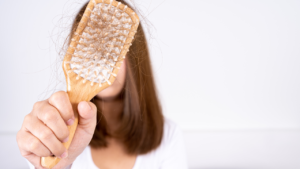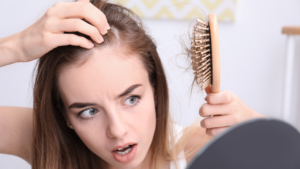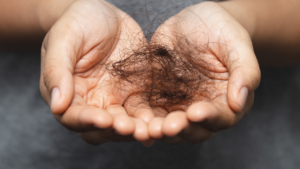Hair loss is a common issue that affects both men and women. By the age of 50, up to 40% of women will experience noticeable hair loss. While men often experience a specific pattern of baldness, women may notice widening of their part or thinning of their ponytail. Understanding the underlying causes of female hair loss is crucial in determining the appropriate prevention and treatment measures.
Key Takeaways:
- Female hair loss is a prevalent issue affecting many women worldwide.
- Female hair loss can manifest as widening of the part or thinning of the ponytail.
- Understanding the causes of female hair loss is essential for effective prevention and treatment.
- Consulting with a healthcare professional is recommended for diagnosis and personalized treatment options.
- Common reasons for hair loss in women include hormonal imbalances, nutritional deficiencies, medical conditions, and medications.
- Treatment options for female hair loss include topical minoxidil, low-light lasers, prescription oral medications, platelet-rich plasma, and microneedling.
- Identifying and modifying styling habits, addressing medical conditions, and seeking emotional support can aid in managing hair loss in women.
The Life Cycle of Hair Growth
Hair grows in cycles and undergoes different phases throughout its life cycle. Understanding the hair growth cycle is essential in comprehending how hair loss occurs and how to effectively address it. The hair growth cycle consists of three main phases: the anagen phase, the catagen phase, and the telogen phase.
The Anagen Phase
The anagen phase is the active growth phase of the hair follicles. Approximately 90% of the hair on the head is in this phase at any given time. During the anagen phase, the hair follicles are nourished by blood vessels and actively produce new hair cells. This phase can last between 2 and 8 years, depending on individual factors such as genetics and overall health. Hair grows about a half-inch per month during this phase.
The Catagen Phase
Following the anagen phase, the hair follicles enter the catagen phase, which is a transitional phase. This phase lasts approximately 2 to 3 weeks. During the catagen phase, the hair follicles shrink and detach from the blood supply. Hair growth stops, and the hair shaft becomes club-shaped. This phase serves as a transition from the active growth phase to the resting phase.
The Telogen Phase
The telogen phase is the resting phase of the hair growth cycle. It typically lasts for 2 to 4 months. During this phase, the hair follicles are at rest, and the hair is no longer actively growing. The old hair remains in the follicle until it is pushed out by the growth of new hair in the anagen phase. On average, people lose 50 to 100 hairs per day during the telogen phase.
Hair Growth Cycle Infographic
| Phase | Description | Duration |
|---|---|---|
| Anagen Phase | The active growth phase of the hair follicles. | 2 to 8 years |
| Catagen Phase | The transitional phase between the active growth and resting phases. | 2 to 3 weeks |
| Telogen Phase | The resting phase where hair is no longer actively growing. | 2 to 4 months |
It is important to note that the hair growth cycle is unique to each individual and can be influenced by various factors such as age, genetics, and overall health. If you are experiencing significant hair loss or visible thinning, it is advisable to consult with a healthcare professional to determine the underlying cause and explore appropriate treatment options.
Causes of Hair Loss in Women
Hair loss in women can be caused by various factors. Understanding these causes is crucial in addressing and treating female hair loss effectively. Some of the common causes include:
- Telogen Effluvium: Telogen effluvium is characterized by a significant increase in hair shedding. It can occur due to factors such as:
- Childbirth
- Severe infections
- Crash diets
- Iron deficiency
- Vitamin D deficiency
- Psychological stress
- Thyroid disease
- Certain medications
- Female Pattern Hair Loss: Female pattern hair loss, also known as androgenetic alopecia, is the most common type of hair loss in women. It is influenced by genetics and hormonal imbalances.
- Nutritional Deficiencies: Lack of essential nutrients, such as iron, vitamin D, and biotin, can contribute to hair loss in women.
- Medical Conditions: Certain medical conditions, including polycystic ovary syndrome (PCOS), thyroid disease, and autoimmune disorders, can cause hair loss in women.
- Medications: Certain medications, such as chemotherapy drugs, hormones, and antidepressants, have been associated with hair loss as a side effect.
It is important to note that hair loss can have multiple causes, and a combination of factors may contribute to the condition. Seeking professional medical advice is crucial for accurate diagnosis and the implementation of appropriate treatment options.
Hair Loss Treatments for Women
Fortunately, there are treatments available to address hair loss in women. Here are some of the most effective options:
1. Topical Minoxidil
Topical minoxidil, available over the counter, is a widely used treatment for both male and female pattern baldness. It is applied directly to the scalp and helps stimulate hair growth by improving blood flow to the hair follicles. Minoxidil is available in different strengths, and consistent use is required to see results.
2. Low-Light Lasers
Low-light lasers, such as laser combs and caps, can stimulate hair follicles and promote hair growth. These devices emit low-level laser therapy (LLLT) that penetrates the scalp, improving blood flow and nutrient delivery to the hair follicles. This non-invasive treatment is often used in combination with other therapies for optimal results.
3. Prescription Oral Medications
Prescription oral medications like finasteride and spironolactone are typically used off-label to treat female pattern hair loss. Finasteride inhibits the hormone dihydrotestosterone (DHT), which plays a role in hair loss, while spironolactone blocks androgen receptors. These medications should be prescribed and closely monitored by a healthcare professional.
4. Platelet-Rich Plasma (PRP)
Platelet-rich plasma (PRP) therapy involves using a patient’s own plasma, rich in growth factors, to stimulate hair growth. The procedure begins with a blood draw, which is then processed to extract the platelet-rich plasma. This plasma is then injected into the scalp to promote hair regrowth.
5. Microneedling
Microneedling, combined with topical minoxidil, is another effective treatment for hair loss in women. This procedure involves creating tiny holes in the scalp with a specialized device, stimulating the production of collagen and enhancing the absorption of topical treatments. Microneedling can help rejuvenate hair follicles and promote healthy hair growth.
Consulting with a doctor is essential to determine the most suitable hair loss treatment based on individual needs and circumstances. They can assess the underlying cause of the hair loss and provide personalized recommendations to help women regain their confidence and manage hair loss effectively.
| Treatment | Description |
|---|---|
| Topical Minoxidil | A topical solution applied directly to the scalp to stimulate hair growth. |
| Low-Light Lasers | Devices that emit low-level laser therapy to stimulate hair follicles. |
| Prescription Oral Medications | Medications like finasteride and spironolactone that target hair loss at a hormonal level. |
| Platelet-Rich Plasma (PRP) | Using a patient’s own plasma to stimulate hair growth. |
| Microneedling | A procedure that creates tiny holes in the scalp to enhance the absorption of treatments. |
Female Hair Loss: Common Patterns and Symptoms
Female hair loss often follows different patterns and symptoms compared to male hair loss. While men commonly experience a receding hairline or a specific bald patch, women tend to have overall thinning of the hair. Common symptoms of hair loss in women include:
- Excessive hair fall during combing or brushing
- Increased hair left on pillows or in the shower drain
- Hair looking thinner
- Visible patches of scalp
Identifying these patterns and symptoms is crucial in effectively addressing hair loss in women.
| Symptoms | Potential Causes |
|---|---|
| Excessive hair fall during combing or brushing | Underlying medical conditions, hormonal imbalances, stress |
| Increased hair left on pillows or in the shower drain | Telogen effluvium, nutritional deficiencies, medications |
| Hair looking thinner | Female pattern hair loss, hormonal imbalances |
| Visible patches of scalp | Autoimmune disorders, traction alopecia |
Understanding these common patterns and symptoms of hair loss in women can aid in determining the underlying causes and appropriate treatment strategies. If experiencing any of these symptoms, it is advisable to consult with a healthcare professional for a proper diagnosis and personalized treatment plan.
Causes of Female Hair Loss
Female hair loss can stem from various causes. Androgenetic alopecia, also known as female pattern hair loss, is the primary cause and has a strong genetic component (1). Other factors contributing to hair loss in women include certain medications and supplements, prior surgeries, health conditions such as polycystic ovary syndrome and thyroid disease, hormone changes during pregnancy or menopause, and periods of high stress (2). Identifying the underlying cause is crucial in determining appropriate treatment options.
Genetics and Androgenetic Alopecia
Androgenetic alopecia, or female pattern hair loss, is the most common cause of hair loss in women. It is influenced by genetics and hormonal imbalances. In this condition, hair follicles become vulnerable to a hormone called dihydrotestosterone (DHT), resulting in gradual thinning of the hair (1).
Medications and Surgeries
Certain medications and surgeries can also contribute to hair loss in women. Chemotherapy drugs, anticoagulants, and medications for thyroid conditions or autoimmune diseases may cause temporary or long-term hair loss. In addition, surgeries that involve anesthesia or significant stress on the body, such as weight loss surgery or major surgeries, can trigger hair loss (2).
Health Conditions and Hormone Changes
Various health conditions can lead to hair loss in women. Polycystic ovary syndrome (PCOS) and thyroid disease are examples of conditions that can disrupt hormone levels and contribute to hair loss. Hormone changes during pregnancy and menopause are also common triggers for hair loss in women (2).
Stress
Stress can have a significant impact on hair health and contribute to hair loss in women. Periods of high stress, such as traumatic events, emotional stress, or chronic stress, can disrupt the hair growth cycle and lead to excessive shedding or thinning of the hair (2).
“Identifying the underlying cause is crucial in determining appropriate treatment options.”
Understanding the potential causes of female hair loss can help women take proactive steps towards prevention and treatment. Identifying any genetic predispositions, assessing medication and surgery history, managing health conditions, and implementing stress management techniques can all contribute to maintaining healthy hair. Consulting with a healthcare professional or dermatologist is recommended for an accurate diagnosis and tailored treatment plan.
Hair Loss Treatment Options for Women
While hereditary hair loss may be inevitable, there are measures that women can take to reduce the risk and manage the condition effectively. Here are some options to consider:
1. Avoid Smoking
Smoking can have a detrimental effect on hair health and contribute to hair loss. By avoiding smoking, women can improve their overall hair condition and reduce the risk of hair loss.
2. Limit Sun Exposure
Excessive sun exposure can damage the hair and scalp, leading to hair loss. It is important for women to limit their exposure to the sun by wearing hats or using protective hair products with SPF.
3. Maintain a Biotin-Rich Diet
Biotin is an essential nutrient that promotes hair growth and strength. Women can include biotin-rich foods in their diet, such as eggs, nuts, avocados, and salmon, or consider taking biotin supplements under the guidance of a healthcare professional.
4. Consider Medications
Medications such as minoxidil and finasteride can be effective in treating hair loss in women. Minoxidil is a topical solution that stimulates hair growth, while finasteride is an oral medication that helps prevent further hair loss. Consult with a dermatologist to determine the most suitable treatment option.
5. Explore Platelet-Rich Plasma (PRP) Therapy
Platelet-rich plasma therapy involves using a patient’s own blood plasma, rich in growth factors, to stimulate hair growth. This non-surgical procedure is performed by a trained healthcare professional and has shown promising results in hair loss treatment.
6. Consider Hair Transplant
In cases of severe hair loss, hair transplant procedures can be considered. This involves transplanting hair follicles from a donor area to the affected area, resulting in natural hair growth. It is important to consult with a specialist to determine if this option is suitable.
Incorporating these treatment options, along with a healthy lifestyle and proper hair care, can help women manage hair loss and promote overall hair health. It is always advisable to consult with a dermatologist or healthcare professional for personalized advice and guidance.
Hormonal Influences on Female Hair Loss
Hormonal changes can have a significant impact on hair loss in women. These changes are often associated with factors such as androgen levels, follicle shrinkage, hormone imbalances, and menopause. Understanding how hormones affect hair growth is crucial in managing and treating hair loss in women.
As women age, changes in androgen levels can lead to the shrinking of hair follicles and thinning of hair strands. Androgens are hormones that play a role in regulating hair growth. When androgen levels are imbalanced, it can negatively affect the hair growth cycle, leading to hair thinning and eventual loss.
During menopause, estrogen levels decrease, which can contribute to hair follicle shrinkage. As a result, women may experience noticeable hair thinning and decreased hair volume. The hormonal changes associated with menopause can have a significant impact on the overall health and appearance of the hair.
Certain conditions, such as polycystic ovary syndrome (PCOS), can also lead to hormonal imbalances and hair loss in women. PCOS is characterized by high levels of androgens, which can cause excessive hair growth in some areas of the body while contributing to hair loss on the scalp.
In cases where hormonal influences play a significant role in hair loss, hormone therapy may be considered as part of the treatment plan. Hormone therapy aims to restore hormonal balance and minimize the impact of androgen imbalances on hair follicles. However, hormone therapy should always be discussed with a healthcare professional to ensure its suitability and potential risks.
Overall, understanding the hormonal influences on female hair loss is essential in guiding effective prevention and treatment strategies. By addressing underlying hormonal imbalances, women can take steps towards restoring hair health and regaining their confidence.
Hair Loss as a Result of Styling Habits and Medical Conditions
Hair loss can be influenced by certain styling habits and medical conditions. Understanding and addressing these factors is crucial in managing and preventing hair loss in women.
Traction Alopecia
One common cause of hair loss is traction alopecia, which occurs due to the repeated tension and pulling on the hair follicles. Tight hairstyles like braids, ponytails, or buns can lead to hair loss in specific areas where the hair is pulled tightly. It is important to avoid excessive tension on the hair and allow the scalp to rest to prevent this type of hair loss.
Styling Habits and High Heat
Styling practices involving high heat, such as frequent use of hot tools like straighteners, curling irons, and blow dryers, can cause hair breakage and thinning. The excessive heat weakens the hair strands, leading to damage and hair loss over time. It is recommended to use heat protectant products and minimize the use of high heat styling tools to preserve the health of the hair.
Harsh Chemicals and Excessive Shampooing
The use of harsh chemicals in hair products, such as strong dyes, relaxers, and perming solutions, can contribute to hair breakage and thinning. Additionally, excessive shampooing and vigorous brushing while the hair is wet can weaken the hair strands and lead to hair loss. It is important to choose gentle, sulfate-free products and handle the hair with care to minimize damage.
Medical Conditions
Certain medical conditions can also cause hair loss in women. Scalp infections, such as ringworm, can lead to hair loss in localized areas. Autoimmune diseases, hormonal changes during pregnancy or menopause, and thyroid imbalances can also contribute to hair loss. Identifying and addressing these medical conditions is essential in managing hair loss and restoring hair health.
By modifying styling habits and addressing underlying medical conditions, women can effectively manage and prevent hair loss. It is advisable to consult with a healthcare professional or dermatologist to determine the most suitable course of action based on individual circumstances and needs.
Psychological Impact of Hair Loss in Women
Hair loss can have a significant psychological impact on women, affecting their confidence and leading to feelings of isolation and depression. Unlike men, women often keep their hair loss to themselves, which may contribute to these emotional struggles. Seeking support and understanding from healthcare professionals, support groups, and loved ones can help women cope with the psychological effects of hair loss and develop strategies for managing it.
Conclusion
Female hair loss is a widespread issue that can affect women of all ages. Understanding the causes and available treatment options is crucial for effectively managing and preventing hair loss in women. By identifying underlying medical conditions, considering hormone therapy, and exploring various treatment avenues, women can address their hair loss concerns and regain their confidence.
Seeking guidance from dermatologists and healthcare professionals is essential in determining the most suitable course of action for each individual. With proper care and treatment, women can take proactive steps towards managing hair loss and preventing further complications.
It is important to remember that each person’s experience with hair loss is unique, and what works for one person may not work for another. Therefore, individualized treatment plans are necessary to address the specific needs of each woman. With determination, support, and the right treatment approach, women can effectively manage hair loss and maintain healthy, beautiful hair.
FAQ
What are the common reasons for hair loss in women?
Hair loss in women can be caused by factors such as telogen effluvium, female pattern hair loss, hormonal imbalances, stress, nutritional deficiencies, medical conditions, and medications.
What is the life cycle of hair growth?
Hair grows in cycles, with the anagen phase (active growth) lasting 2 to 8 years, the catagen phase (transition) lasting 2 to 3 weeks, and the telogen phase (resting) lasting 2 to 4 months before hair falls out.
How is hair loss treated in women?
Treatment options for hair loss in women include topical minoxidil, low-light lasers, prescription oral medications, platelet-rich plasma therapy, and microneedling.
What are the common patterns and symptoms of female hair loss?
Female hair loss is characterized by overall thinning rather than specific bald patches. Common symptoms include excessive hair fall during grooming, thinning hair, and visible patches of scalp.
What are the common causes of female hair loss?
Female hair loss can be caused by androgenetic alopecia (female pattern hair loss), genetics, medications, surgeries, health conditions, hormone changes, and stress.
What are the treatment options for female hair loss?
Treatment options for female hair loss include smoking avoidance, limiting sun exposure, maintaining a healthy diet rich in biotin, using medications such as minoxidil and finasteride, platelet-rich plasma therapy, and hair transplant procedures.
How do hormonal imbalances influence female hair loss?
Hormonal changes, such as those during menopause or associated with conditions like polycystic ovary syndrome, can lead to hair follicle shrinkage and thinning hair strands. Hormone therapy may be considered to manage these imbalances.
Can styling habits and medical conditions cause hair loss in women?
Yes, tight hairstyles, styling practices involving high heat or harsh chemicals, excessive shampooing, and certain medical conditions such as scalp infections can contribute to hair loss in women.
What is the psychological impact of hair loss in women?
Hair loss can have a significant psychological impact on women, affecting their confidence and leading to feelings of isolation and depression. Seeking support from healthcare professionals, support groups, and loved ones can help women cope with these effects.
How can women prevent and manage hair loss?
Women can reduce the risk of hair loss by avoiding smoking, limiting sun exposure, maintaining a healthy diet rich in biotin, and seeking appropriate treatment options for underlying causes. Consulting with a dermatologist is essential for personalized prevention and treatment plans.
You may also be interested in
Understanding What Causes Sudden Hair Loss in Females
Effective Solutions for Managing Hair Loss – Your Healthy Scalp Guide
Unveiling Your Best Body Care Routine for Glowing Skin
Get Gorgeous with Our Must-Have Makeup Tips and Trends
Effective Hair Treatment for Women – Revitalize Your Locks Today!
Source Links
- https://www.uclahealth.org/news/what-causes-female-hair-loss
- https://www.webmd.com/skin-problems-and-treatments/hair-loss/women-hair-loss-causes
- https://www.nebraskamed.com/dermatology/hair-loss-in-women-what-causes-it-and-how-to-stop-it






